Research News
-
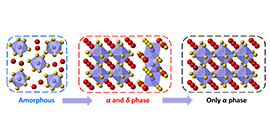 10 27, 2020Scientists Fabricate Efficiency Large-area Perovskite Solar Module using Slot-Die CoatingScientists from DICP fabricated high efficiency large-area perovskite solar module using slot-die coating with high-pressure nitrogen-extraction (HPNE) and effective passivation strategy.
10 27, 2020Scientists Fabricate Efficiency Large-area Perovskite Solar Module using Slot-Die CoatingScientists from DICP fabricated high efficiency large-area perovskite solar module using slot-die coating with high-pressure nitrogen-extraction (HPNE) and effective passivation strategy.
The slot-die coating is a promising deposition technique due to its advantages in low cost, high throughput, continuous roll-to-roll fabrication. However, it remains a challenge to control thin film uniformity over a large area at thickness as thin as 500 nm while maintaining crystallization quality.
Recently, a research group led by Prof. LIU Shengzhong from the Dalian Institute of Chemical Physics (DICP) of the Chinese Academy of Sciences (CAS) fabricated highly-efficiency large-area perovskite solar module using slot-die coating.
This study was published in Advanced Materials on October 20.
Schematic illustration of the evolution of perovskite film prepared via slot‐die coating with HPNE strategy (Image by DU Minyong and DUAN LianJie)
The scientists reported their development of an effective high-pressure nitrogen-extraction (HPNE) strategy that drove formation of a stable intermediate phase and allowed the coating to grow into a uniform dense perovskite film. As a result, they achieved a wide processing window in the large-area printing process.
Furthermore, an effective passivation process was developed using an ionic liquid to achieve solar cell efficiency as high as 22.7%. More importantly, the strategies were successfully scaled-up to large-area solar cell fabrication and a 40×40 mm2 perovskite solar cell (PSC) module attained stabilized power conversion efficiency as high as 19.4%, which was the highest efficiency for large-area module to date.
These results suggest that this controlled printing with HPNE strategy is a highly-efficient, wide-window, cost-effective, area-scalable technique for fabrication of PSCs, which will advance the development of slot-die coating as well as its application to high-throughput roll to roll deposition.
This work was supported by the Strategic Priority Research Program of the Chinese Academy of Sciences, the National Nature Science Foundation of China, the Doctor Startup Foundation of Liaoning Province, the Innovation Fund Project of Dalian Institute of Chemical Physics, the Cooperation Foundation of Dalian National Laboratory For Clean Energy of the Chinese Academy of Sciences, the National Key Research Program of China, the 111 Project, and the Project of Knowledge Innovation Engineering. (Text by DU Minyong and DUAN LianJie) -
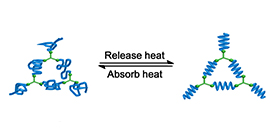 10 27, 2020Scientists Develop Flexible Phase Change Film for Wearable Thermal DeviceScientists from DICP developed an intrinsically flexible phase change film by a facile synthetic strategy, and integrated it into wearable devices with a flexible graphene film.
10 27, 2020Scientists Develop Flexible Phase Change Film for Wearable Thermal DeviceScientists from DICP developed an intrinsically flexible phase change film by a facile synthetic strategy, and integrated it into wearable devices with a flexible graphene film.
Phase change materials (PCMs) involving significant amounts of latent heat absorbing and releasing at a constant transition temperature have been utilized for thermal management of electronic devices. However, it is a challenge to apply thermal management for wearable devices using traditional PCMs due to their solid rigidity and liquid leakage.
Recently, a research group led by Prof. SHI Quan from the Dalian Institute of Chemical Physics (DICP) of the Chinese Academy of Science (CAS), in collaboration with Prof. WU zhongshuai from the DICP, developed an intrinsically flexible phase change film by a facile synthetic strategy, and integrated it into wearable devices with a flexible graphene film.
This work was published in Energy Storage Materials on October 17.
An intrinsically flexible phase change film with remarkable shape tailorability and foldability exhibits superior performance in wearable thermal managements (Image by KOU Yan and SUN Keyan)
This PCM film showed adjustable phase transition enthalpy and temperature in the region from 5 to 60 °C, as well as long-term cycling stability up to 1000 cycles. Furthermore, it could be easily integrted into wearable thermal management devices with a flexible graphene film, due to the features of intrinsic flexibility, self-support and shape-conformable property, as well as remarkable shape tailorability and foldability.
This device exhibited stable temperature control performance at different device shapes and temperatures, and the highest electro-thermal energy conversion efficiency could reach to 94%.
Scientists had sewed this temperature control device on a lab coat, which behaved excellent flexibility and shape-conformability in the bending action process.
This work is potential for next-generation flexible thermal management electronics.
This work was supported by the DICP Innovation Funding and the National Natural Science Foundation of China. (Text by KOU Yan and SUN Keyan) -
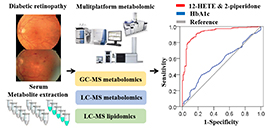 10 12, 2020Serum Metabolic Marker Analysis Helps Rapid Screening and Early Diagnosis of Diabetic RetinopathyScientists found that 12-hydroxy arachidonic acid (12-HETE) and 2-piperidone are suitable for the diagnosis of diabetic retinopathy, particularly for early screening of diabetic retinopathy.
10 12, 2020Serum Metabolic Marker Analysis Helps Rapid Screening and Early Diagnosis of Diabetic RetinopathyScientists found that 12-hydroxy arachidonic acid (12-HETE) and 2-piperidone are suitable for the diagnosis of diabetic retinopathy, particularly for early screening of diabetic retinopathy.
The prevalence of diabetes is continuously increasing all over the world. The International Diabetes Federation estimated that in 2045 around 700 million people will suffer from diabetes.
Diabetic retinopathy (DR) is one of the most common and serious microvascular complications of diabetes. Screening and early diagnosis of DR are important for the prevention and treatment of this disease. The lack of effective diagnostic biomarkers for DR leads to unsatisfactory curative treatments.
Multiplatform metabolomics reveals novel serum metabolite biomarkers in diabetic retinopathy subjects (Image by XUAN Qiuhui and WANG Ting)
Recently, A research group led by Prof. XU Guowang from the Dalian Institute of Chemical Physics (DICP) of the Chinese Academy of Sciences, in collaboration with Prof. JIA Weiping from the Sixth People's Hospital of Shanghai Jiao Tong University and Prof. WU Jiarui from the Institute of Biochemistry and Cell Biology of the Chinese Academy of Sciences, found that 12-hydroxy arachidonic acid (12-HETE) and 2-piperidone are suitable for the diagnosis of DR, particularly for early screening of DR.
This study was published in Advanced Science on Oct. 1.
The scientists used mulitplatform metabolomics methods to analyze the serum samples from 905 participants, and to provide comprehensive insights into the abnormal metabolic characteristic and disordered metabolic pathways involved in the onset and development of DR.
Through multivariate/univariate statistical analysis, a novel marker panel consisting of 12-HETE and 2-piperidone was discovered and validated by a two-step strategy. And the panel was able to perform rapid and accurate diagnosis of DR in vitro, showing high diagnostic performance with sensitivity of 80.5 - 89.4%, specificity of 91.9 - 93.3%, and area under the receiver operating characteristic curve (AUC) of 0.928 - 0.946.
Moreover, the marker panel also showed significant advantages in the early diagnosis of DR, with sensitivity of 81.6 - 92.9%, specificity of 90.1 - 93.3%, and AUC of 0.925 - 0.958.
This study provides a reliable, efficient and convenient new method for the detection of DR with a small amount of serum.
This study was supported by the foundations and key foundation from the National Natural Science Foundation of China, the National Key Research and Development Program of China, and the innovation program of science and research from the Dalian Institute of Chemical Physics, Chinese Academy of Sciences. (Text by XUAN Qiuhui and WANG Ting) -
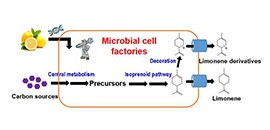 09 29, 2020Scientists Produce Limonene and its Derivatives from MicrobeScientists discussed the engineering microbes for biosynthesis of limonene and its derivations.
09 29, 2020Scientists Produce Limonene and its Derivatives from MicrobeScientists discussed the engineering microbes for biosynthesis of limonene and its derivations.
Limonene and its derivatives are widely used in industry and pharmaceuticals. Currently, limonene production is mainly dependent on extraction from natural plants or chemical synthesis, which may suffer from feedstock shortage, unstable supply chain and low production efficiency.
Development in metabolic engineering and synthetic biology offers a promising alternative for constructing microbial cell factories to realize the sustainable and efficient supply of limonene and its derivatives.
However, there are still challenges in engineering microbial cell factories for the biosynthesis of limonene and its derivatives, including discovery and characterization of key enzymes, accurate regulation of host cell metabolism and the serious cytotoxicity of limonene on chassis cells.
Recently, a research group led by Prof. ZHOU Yongjin from the Dalian Institute of Chemical Physics of the Chinese Academy of Sciences, in collaboration with Prof. YANG Xiaobing's group from Northwest A&F University, discussed the engineering microbes for biosynthesis of limonene and its derivations.
The result was published on Biotechnology Advances on September 1.
Microbial cell factories for limonene and its derivatives synthesis (Image by REN Yuyao)
The scientists reviewed engineering microbes for limonene biosynthesis and derivation with the emphasis on enzyme characterization and pathway optimization. In particular, they introduced the current trends in microbial limonene decoration for the biosynthesis of bio-active molecules such as α-terpineol and perillyl alcohol.
They summarized the key engineering strategies toward robust microbial cell factories, including strengthening and balancing metabolic pathways, enhancing the key rate-limiting step, improving cofactor supply and relieving the cytotoxicity of limonene.
This work was supported by the National Key Research and Development Program of China, National Natural Science Foundation of China, and Liaoning Revitalization Talent Program. (Text by LI Yunxia) -
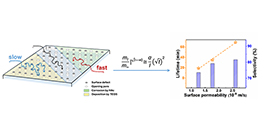 09 29, 2020Controlling Surface Barriers to Modulate SAPO-34 Catalyzed Methanol-to-olefin ReactionScientists from DICP regulated the catalytic lifetime and the light olefins selectivity of Methanol-to-olefins (MTO) process by controlling the surface barriers of SAPO-34 zeolites.
09 29, 2020Controlling Surface Barriers to Modulate SAPO-34 Catalyzed Methanol-to-olefin ReactionScientists from DICP regulated the catalytic lifetime and the light olefins selectivity of Methanol-to-olefins (MTO) process by controlling the surface barriers of SAPO-34 zeolites.
Mass transfer of guest molecules in nanoporous crystalline materials is significant in spanning heterogenous catalysis and gas separation. Intracrystalline diffusion is intrinsic to molecular properties and material structures, and surface barriers represent another important transport mechanism.
In many processes, surface barriers of guest molecules may dominate the overall mass transport rate in zeolite catalysts. Although the importance of surface resistance in mass transfer over zeolite crystals is considered, controlling the performance of catalytic reaction by direct modulation of surface barriers remains challenging.
Recently, a research group led by Prof. YE Mao and Prof. LIU Zhongmin from the Dalian Institute of Chemical Physics (DICP) of the Chinese Academy of Sciences studied the mass transfer in the zeolite surface. They regulated the catalytic lifetime and the light olefins selectivity of Methanol-to-olefins (MTO) process by controlling the surface barriers of SAPO-34 zeolites.
The study was published in Angew. Chem. Int. Ed. on Sept. 3.
The reduction of surface barriers could prolong catalyst lifetime and promote light olefins selectivity (Image by LI Hua)
"We modified SAPO-34 zeolites by chemical liquid deposition and acid etching," said Prof. YE.
According to the surface permeability formula, surface permeabilities of guest molecules for these zeolites could be directly measured. Meanwhile, the morphology, pore structure, acid properties and intracrystalline diffusivity were almost unchanged during the modification.
The results showed that a decrease in surface barriers could speed up the transfer of guest molecules inward and outward the zeolite crystal, and improved the catalytic lifetime and the selectivity of light olefins.
This work demonstrated that the controlling of surface barriers in SAPO-34 zeolites could be applied to modulate catalytic performance. It opens up a way to improve reaction performance by controlling mass transport of guest molecules in zeolite catalysis.
The research was supported by the National Natural Science Foundation of China. (Text by LI Hua) -
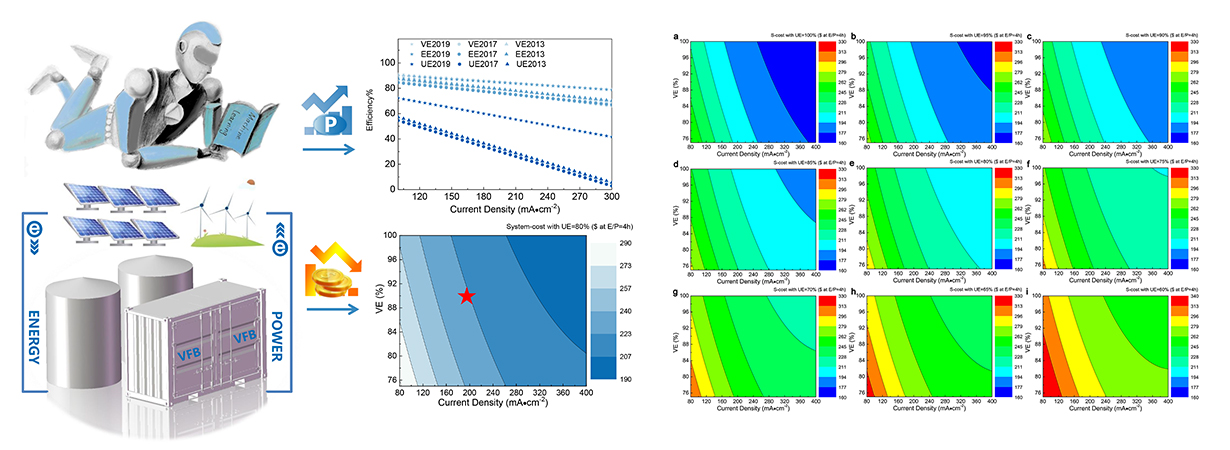 09 29, 2020AI Technology Can Predict Vanadium Flow Battery Performance and CostA research team led by Prof. LI Xianfeng from the Dalian Institute of Chemical Physics (DICP) of the Chinese Academy of Sciences proposed a machine learning-based strategy to predict and optimize the performance and cost of VFBs.Vanadium flow batteries (VFBs) are promising for stationary large-scale energy storage due to their high safety, long cycle life, and high efficiency.The cost of a VFB system mainly depends on the VFB stack, electrolyte, and control system. Developing a VFB stack from lab to industrial scale can take years of experiments due to complex factors, from key materials to battery architecture.Novel methods to accurately predict the performance and cost of a VFB stack and further system are needed in order to accelerate the commercialization of VFBs.Recently, a research team led by Prof. LI Xianfeng from the Dalian Institute of Chemical Physics (DICP) of the Chinese Academy of Sciences proposed a machine learning-based strategy to predict and optimize the performance and cost of VFBs."We use AI technology to improve efficiency, reduce research time, and provide important guidance for the research and development of VFBs," said Prof. LI. "It may accelerate the commercialization of VFBs."This work was published in Energy & Environmental Science on Sept. 22.Cost, performance prediction and optimization of a vanadium flow battery using machine learning (Image by LI Tianyu)The proposed strategy takes operating current density as the main feature, and the material and structure of the stack as auxiliary features.This machine learning model can predict the voltage efficiency, energy efficiency, and electrolyte utilization ratio of the VFB stack, as well as the power and energy cost of the VFB system with high accuracy.In addition, a future R&D direction for the VFB stack was proposed based on model coefficients of machine learning, i.e., developing high-power density VFB stacks under conditions of higher voltage efficiency and higher electrolyte utilization ratio.This work not only has great significance for the R&D of VFB stacks, but also highlights the prospects for combining machine learning and experiments for optimizing and predicting the dynamic behavior of complex systems.This study was supported by the National Natural Science Foundation of China, the Strategic Priority Research Program of the Chinese Academy of Sciences, the CAS Engineering Laboratory for Electrochemical Energy Storage, and the Liaoning Revitalization Talents Program. (Text by LI Tianyu)
09 29, 2020AI Technology Can Predict Vanadium Flow Battery Performance and CostA research team led by Prof. LI Xianfeng from the Dalian Institute of Chemical Physics (DICP) of the Chinese Academy of Sciences proposed a machine learning-based strategy to predict and optimize the performance and cost of VFBs.Vanadium flow batteries (VFBs) are promising for stationary large-scale energy storage due to their high safety, long cycle life, and high efficiency.The cost of a VFB system mainly depends on the VFB stack, electrolyte, and control system. Developing a VFB stack from lab to industrial scale can take years of experiments due to complex factors, from key materials to battery architecture.Novel methods to accurately predict the performance and cost of a VFB stack and further system are needed in order to accelerate the commercialization of VFBs.Recently, a research team led by Prof. LI Xianfeng from the Dalian Institute of Chemical Physics (DICP) of the Chinese Academy of Sciences proposed a machine learning-based strategy to predict and optimize the performance and cost of VFBs."We use AI technology to improve efficiency, reduce research time, and provide important guidance for the research and development of VFBs," said Prof. LI. "It may accelerate the commercialization of VFBs."This work was published in Energy & Environmental Science on Sept. 22.Cost, performance prediction and optimization of a vanadium flow battery using machine learning (Image by LI Tianyu)The proposed strategy takes operating current density as the main feature, and the material and structure of the stack as auxiliary features.This machine learning model can predict the voltage efficiency, energy efficiency, and electrolyte utilization ratio of the VFB stack, as well as the power and energy cost of the VFB system with high accuracy.In addition, a future R&D direction for the VFB stack was proposed based on model coefficients of machine learning, i.e., developing high-power density VFB stacks under conditions of higher voltage efficiency and higher electrolyte utilization ratio.This work not only has great significance for the R&D of VFB stacks, but also highlights the prospects for combining machine learning and experiments for optimizing and predicting the dynamic behavior of complex systems.This study was supported by the National Natural Science Foundation of China, the Strategic Priority Research Program of the Chinese Academy of Sciences, the CAS Engineering Laboratory for Electrochemical Energy Storage, and the Liaoning Revitalization Talents Program. (Text by LI Tianyu)